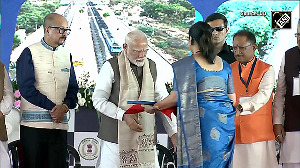India on Monday successfully flight-tested the indigenously-developed hypersonic technology demonstration vehicle (HSTDV), joining a select group of countries having the capability to develop the next-generation hypersonic cruise missiles, officials said.

The HSTDV, based on hypersonic propulsion technologies and developed by the Defence Research and Development Organisation (DRDO), will help India develop futuristic space assets like long-range missile systems and aerial platforms, they said.
The HSTDV is capable of powering missiles to attain a speed of around Mach 6 or six times the speed of sound, the officials said, adding only a very few countries like the United States, Russia and China have such a capability.
'The DRDO has successfully demonstrated the hypersonic air-breathing scramjet technology with the flight test of hypersonic technology demonstration vehicle at 11.03 am from A P J Abdul Kalam launch complex at Wheeler Island, off the coast of Odisha today,' the defence ministry said in a statement.
The HSTDV operates on a scramjet engine, as against the ramjet engine which is used on most missiles. The ramjet engines operate at supersonic speeds of up to Mach 3.
The ministry said all the performance parameters have indicated a resounding success of the mission. The successful test comes over a year after a similar attempt did not provide expected results
Defence Minister Rajnath Singh congratulated the DRDO over the successful test-flight of the HSTDV, calling it a 'landmark achievement'.
'I congratulate DRDO on this landmark achievement towards realising PM's vision of Atmanirbhar Bharat. I spoke to the scientists associated with the project and congratulated them on this great achievement. India is proud of them,' he tweeted.
A DRDO official said that with the successful test flight of the HSTDV, India has demonstrated capabilities for highly complex technology that will serve as the building block for next-generation hypersonic vehicles in partnership with the domestic defence industry.
The defence ministry said the parameters of launch and cruise vehicle, including the scramjet engine, were monitored by multiple tracking radars, electro-optical systems and telemetry stations.
'The scramjet engine worked at high dynamic pressure and very high temperature. A ship was also deployed in the Bay of Bengal to monitor the performance during the cruise phase of hypersonic vehicle,' the ministry said.
With the successful test, it said many critical technologies such as aerodynamic configuration for hypersonic manoeuvres, use of scramjet propulsion for ignition and sustained combustion at hypersonic were proven and validated.
It said the hypersonic cruise vehicle was launched using a proven rocket motor, which took it to an altitude of 30 kilometres where the aerodynamic heat shields were separated.
'The cruise vehicle separated from the launch vehicle and the air intake opened as planned. The hypersonic combustion sustained and the cruise vehicle continued on its desired flight path at a velocity of six times the speed of sound,' the ministry said.
It said the critical events like fuel injection and auto ignition of scramjet demonstrated technological maturity and that the scramjet engine performed in a 'textbook manner'.











 © 2025
© 2025